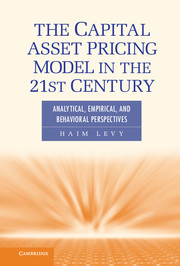 The Capital Asset Pricing Model in the 21st Century
The Capital Asset Pricing Model in the 21st Century Book contents
- Frontmatter
- Contents
- Preface
- 1 Introduction
- 2 Expected Utility Theory
- 3 Expected Utility and Investment Decision Rules
- 4 The Mean-Variance Rule (M-V Rule)
- 5 The Capital Asset Pricing Model
- 6 Extensions of the Capital Asset Pricing Model
- 7 The Capital Asset Pricing Model Cannot Be Rejected
- 8 Theoretical and Empirical Criticism of the Mean-Variance Rule
- 9 Prospect Theory and Expected Utility
- 10 Cumulative Decision Weights
- 11 The Mean-Variance Rule, the Capital Asset Pricing Model, and the Cumulative Prospect Theory
- References
- Name Index
- Subject Index
4 - The Mean-Variance Rule (M-V Rule)
Published online by Cambridge University Press: 05 June 2012
- Frontmatter
- Contents
- Preface
- 1 Introduction
- 2 Expected Utility Theory
- 3 Expected Utility and Investment Decision Rules
- 4 The Mean-Variance Rule (M-V Rule)
- 5 The Capital Asset Pricing Model
- 6 Extensions of the Capital Asset Pricing Model
- 7 The Capital Asset Pricing Model Cannot Be Rejected
- 8 Theoretical and Empirical Criticism of the Mean-Variance Rule
- 9 Prospect Theory and Expected Utility
- 10 Cumulative Decision Weights
- 11 The Mean-Variance Rule, the Capital Asset Pricing Model, and the Cumulative Prospect Theory
- References
- Name Index
- Subject Index
Summary
Introduction
The Mean-Variance (M-V) rule is employed mainly when ranking various prospects and when constructing efficient portfolios out of the individual risky assets that are available. Most important, the M-V rule is the foundation of the Capital Asset Pricing Model (CAPM), particularly of beta as a measure of risk. The M-V rule, the CAPM, and particularly beta are probably the most commonly employed investment criteria by academics and practitioners alike.
Is there a theoretical or an empirical justification to the widespread employment of the M-V rule? Under what conditions is it safe to employ the M-V rule, and under what conditions may doing so lead to paradoxical results? We devote this chapter to these issues. We first define the M-V rule, and then we show cases in which it is consistent with expected utility and cases in which it leads to paradoxical results. Specifically, we show that when the utility function is quadratic (with no need to require that returns be normally distributed) or, alternatively, when one is ready to assume a normal distribution with risk aversion, it is legitimate to employ the M-V rule. The word legitimate rather than optimal is employed to emphasize that the M-V rule is not always the optimal one. To be more specific, in the quadratic case, the M-V rule is sufficient but not necessary and hence can be improved. Indeed, in the quadratic utility function case, we suggest in this chapter sharper investment decision rules than the M-V rule. In contrast to the quadratic case, in the normal case, the M-V rule is sufficient and necessary; hence, it is optimal. Therefore, unlike in the quadratic preference case, in the normal case, one cannot establish a better rule than the M-V rule. Finally, we illustrate that even when one cannot theoretically justify employment of the M-V rule (i.e., neither quadratic preference nor normality prevail), in a wide spectrum of cases, it can serve as an excellent approximation to expected utility maximization. Thus, in the last part of this chapter, we answer (accompanied with an empirical demonstration) the question raised by Markowitz in his Nobel Laureate speech:
The crucial question is: if an investor with a particular single period utility function acted only on the basis of expected return and variance, could the investor achieve almost maximum expected utility? Or put it another way, if you know the expected value and variance of the probability distribution of return on a portfolio can you guess fairly closely its expected utility? (p. 471)
We would like to add the following question:
Selecting an investment portfolio by some function of the mean and variance, f(μ, σ2), which is an approximation to expected utility (as suggested by Markowitz), is it certain that an M-V efficient portfolio is chosen? If the answer is a negative one, it implies that an M-V inefficient, or an interior, portfolio may be selected by the suggested approximation, which could be a severe drawback of this approximation.
We show in this chapter that the answer to Markowitz's question is positive, whereas the answer to our added question is that in some cases, the answer is negative, but in the most relevant economic case, the answer is positive. When investors are willing to add to the risk aversion assumption also decreasing absolute risk aversion (DARA), they will always choose a portfolio from the M-V efficient frontier when choosing according to the suggested approximation to the expected utility. Hence, the market portfolio must be located on this frontier, and the CAPM is intact (see also Chapters 5 and 6).
- Type
- Chapter
- Information
- The Capital Asset Pricing Model in the 21st CenturyAnalytical, Empirical, and Behavioral Perspectives, pp. 63 - 116Publisher: Cambridge University PressPrint publication year: 2011


